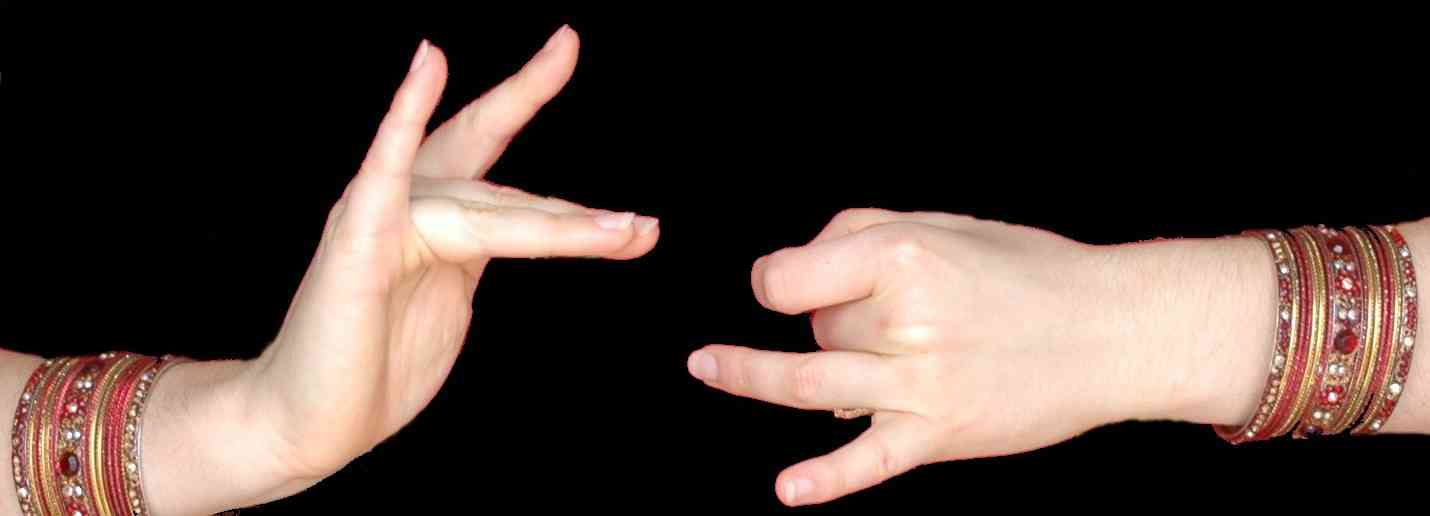

|
|
 |
|
|
of Sleep
The tales, which I will tell, are not out of dusty books. Everything fantastic and wonderful in my show, is alive in India, in the more humble people’s memories.
Trips to India : I go regularly, for four years, to India, to Kerala, art and coconut palm country. There, I learn Indian dances (bharatanatyam, mohiniatam and kathakali) in intensive manner with Indian professors. But, above all, I live among them, I live like them.
To live in India, even one or two months, you have to enter into this culture and set aside yours ownscertitudes.
Bénarès Cartesianism has no place in their daily lives. They explain reality or other facts with beliefs, gods, or their cosmic law, « the Dharma ». This atmosphere, whether we adhere or not, is propitious to story-telling. The Indians’ view of life is mystical. They live in mythology. The fantastic, which in France we introduce in legends, belongs to their everyday existences.
The Hindu Mythology :
Mythology, however old (some texts come from the fifth millennium before J-C) is incredibly alive in India. All of art refers to it, altars to one of numberless gods strews each town, each village, and even each house. Temples are full and sacred places attract millions of pilgrims. Hindu myths are what is the stablest and the most anchored at the heart of Indian culture. They are accompanied by beliefs and rituals.
Shiva Nataraja, the cosmic dance's god
The Indian dance is directly in relation with this universe. It carries sacred texts and it is always offered to a god – often Shiva Nataraja, the cosmic dance’s god. The show’s purpose is not to convert to the Hindu religion, of course. Nor even to believe, like Indians, in the reality of characteres and gods who appear on the stage. But, their mythology is incredibly rich. It reveals human beings, like Greek mythology. And permits to enter in the Indian culture ‘s very heart. So I propose in this show an Indian approch .
Writing : Written from importants texts (Purana Shiva, Parvati of Kalidasa, …) and with my research in India, this show is moulded with the sensuality which lives in this country – colors, flavors, foods, songs, rituals… everything which stimulates the imagination. I have rewritten two myths – the Ganga’s descent on the earth and Shiva and Parvati’s love – in order to make them audible to western children and adults, who haven’t the mythological references which all Indians have. One river descends on the earth to purify the human being, a goddess is captured in a big god’s chignon, Uma – the Night’s Peace – must conquer the love of Lord of Sleep ; Kama – the God of Love – become invisible. Here is India in what it has as the most marvelous, with its essences and its spices, its nature which shelters numberless nymphs, its gods who hide behind all hazards. I have chosen Shiva as principal protagonist because he is one of the three most important gods, one of them who are the most revered, and, above all, because he seems to be the most excessive, the most alive. He passes from one extreme to another, contains one thing and its opposite, in harmony which is amazing for us, westerners. He repulses and amazes. He is the « Lord of Tears » and the « Beneficent » He is the ascetic and the power of desire. He is the one who reduces Kama to ashes– the God of Desire – and the one who forms a perfect couple with Parvati
Shiva, Parvati and their son Ganesh
The play’s hands : the mudras The Indian dance uses a hand language called mudras. It’s a sign language - very beautiful, stylized and choreographed. The hands speak, but also present characters and gods. There are language and puppets. There are signifier and signified. There are precise and powerful looks, and always with facial expressions. I use these to bring to life my tale in a code of pictures and movements. Besides these functions are rhythms, rituals on the stage, which pom time-to-time go into the dance.
mudras of beautiful woman
Indian dances : The Indian dance adorns, illustrates and brings rituals into the tales. In these dances, heroes and gods are represented by postures and movements. In this show, I dance to present different characters in different moments (presentation, Ganga’s descent, love, …)
For this, I use three types of dances :
It is only the body which incarnates characters : energy, rhythmic, postures, choice of dance, hands and facial expressions.
So, the imaginary keeps its importance because I don’t change costumes or make-up to show a more realistic picture. The dance carries Indian attitudes and rituals, which find their place in my show. As ritual is a fundamental element in the tale, the dance accentuates and supports this fantastic atmosphere.
Writting and interpretation : Lucile Hannesse
|
|
|